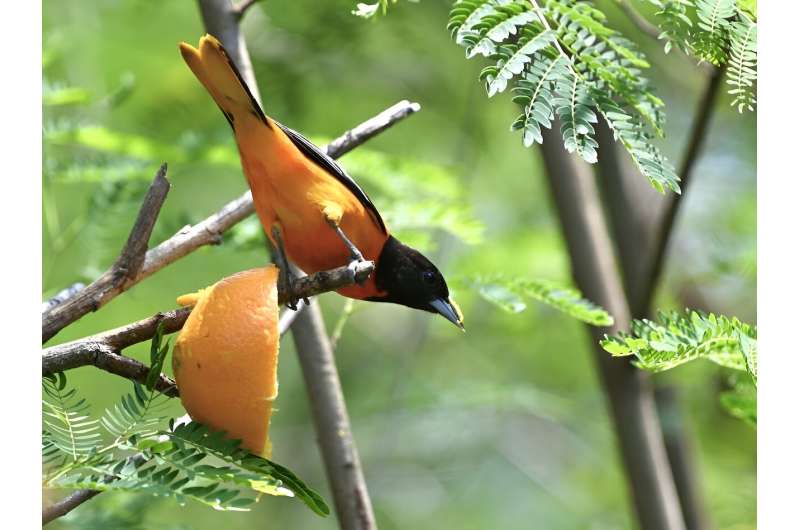This article has been reviewed according to Science X's editorial process and policies. Editors have highlighted the following attributes while ensuring the content's credibility:
fact-checked
trusted source
written by researcher(s)
proofread
Artificial light lures migrating birds into cities, where they face a gauntlet of threats

Light pollution has steadily intensified and expanded from urban areas, and with the advent of LED lighting, it is growing in North America by up to 10% per year, as measured by the visibility of stars in the night sky. In our recent study, we found that the glow from cities and urban outskirts can powerfully attract migratory birds, drawing them into developed areas where food is scarcer and they face threats such as colliding with glass buildings.
Each spring and fall, migratory birds journey to or from their breeding grounds, sometimes traveling thousands of miles. En route, most birds need to make stopovers to rest and feed. Some species burn off half of their body mass during migration.
Migratory stopover sites are not random, and birds typically use the same locations from year to year. Because migration takes place on a continental scale, with billions of birds crossing North America each migratory season, it's important for scientists to understand what attracts birds to these locations.
We found that light pollution was a top predictor of the density of migrating birds at stopover locations for both spring and fall migration across the continental U.S.
Why it Matters
Nearly all birds in North America—some 80%—migrate each spring and fall. And of those species that migrate, 70% travel at night.
Nocturnal migration has many adaptive benefits: For example, the weather conditions are better, and fewer predators are active. But it makes most migratory birds highly susceptible to light pollution. In North America alone, it is estimated that up to 1 billion migrating birds die each year from collisions with buildings.
Scientists don't yet know why nocturnally migrating birds are attracted to artificial light, but research has shown that light pollution acts as an amplifying agent that draws more songbirds into urbanized areas. It often co-occurs with other environmental threats, such as water and air pollution and noise. All of these stressors disrupt birds' behavioral and physiological processes during journeys that already are extremely taxing.
Lighting is part of the fabric of human structures, yet many people don't think of it as a pollutant or perceive its harmful effects on nature—until events like the mass bird loss in Chicago on Oct. 4-5, 2023, when nearly 1,000 birds were killed after colliding with the McCormick Place Convention Center, make the problem impossible to ignore.
How we did our work
With colleagues at Colorado State University, Michigan State University, the University of Delaware, the Cornell Lab of Ornithology, Princeton University, the University of Massachusetts Amherst and the National Park Service, we sought to understand the complex drivers and large-scale patterns of stopover density by combining remote sensing data with geospatial tools. Mapping stopover locations has been a bird conservation priority for many years; now, for the first time, we have a complete view of where these stopovers are across the United States.
We were able to make novel maps at a continental scale using U.S. NEXRAD weather surveillance data—information from the same radars that meteorologists draw on to predict weather patterns on television and weather apps. We created 2,500 models using roughly 1 million locations across the U.S. and 49 predictor variables, including forest cover, precipitation, temperature, elevation and skyglow—diffuse brightness in the night sky from artificial light.
These maps capture fine-scale details that allow us to see increased densities of migrating birds following the winding banks of the Mississippi River, which provide an important refuge for depleted migrants to rest and refuel. We also created fall and spring hotspot maps highlighting regions where especially high numbers of birds made stopovers.
We found that the presence of light pollution was a better predictor of bird densities than temperature, precipitation or tree canopy cover. These all were variables that we had expected to correlate with periods when birds would be on the ground, or with high-quality habitats where birds would be likely to stop over.
Other variables were associated with areas that birds were unlikely to use as stopovers. One example was the presence of agricultural crops, such as corn or soybeans. Fields planted with a single crop don't provide adequate food or shelter for many bird species, so migrants are unlikely to rest there.
Light pollution is a human-induced change to the environment that may act as an ecological trap, drawing birds into substandard habitats and increasing their risk of collisions with buildings. Happily, its immediate effects can be quickly reversed with the flip of a switch.
Working to reduce artificial light through Lights Out campaigns and migration alerts, understanding when birds will be in airspaces and using bird-friendly glass that has patterns across its surface to make it more visible to birds, will reduce bird deaths from light pollution. Understanding the drivers and macro-scale patterns of stopover densities across the continental U.S. will better inform conservation actions like these.
Provided by The Conversation
This article is republished from The Conversation under a Creative Commons license. Read the original article.![]()




















